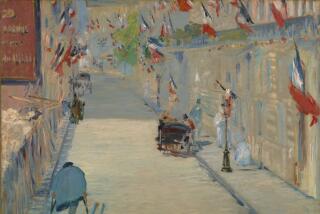Casting a New Light on Monet’s Paintings
PARIS — It was originally meant to be a sort of indoor garden, an oasis in a big city. Instead, the Paris museum gallery that held eight of Claude Monet’s shimmering “water lilies” paintings was drab and sunless, with a low ceiling.
Now, the Orangerie Museum is getting a major overhaul. When work is finished in fall 2004, the museum will show off the paintings the way Monet wanted them to be seen: under skylights, their watery blue-green hues changing color as the sun shifts overhead.
“The heart of this project was to find a way to bring the water lilies back into natural light,” said Olivier Brochet, the architect behind the project.
A glass roof will let the light in. New doors will let people stroll straight into the water lilies rooms from the Tuileries Gardens, with its shady gravel pathways and a pool where children float sailboats.
These days, the Orangerie’s corner of the tranquil garden is a bustling work site. On its upper window ledges, workers smash out panes of glass and toss wooden planks into a trash bin.
The museum has been closed since January 2000, with most of its paintings on a worldwide tour. The water lilies’ panels, built into the walls, couldn’t travel with the rest of the collection.
Monet painted hundreds of works of water lilies; eight of the most famous are housed in the Orangerie. For the last three decades of his life, Monet’s main subject was his front yard in the small French town of Giverny, with its lily-filled pond, Japanese bridge and weeping willows.
Capturing natural light was the Impressionist painter’s lifelong obsession. He painted his subjects at all times of day, helping popularize the art of painting in open air. Before Monet’s time, artists generally did sketches outside, but saved the difficult work of painting for the studio.
When the renovation is finished, the Orangerie will pay tribute to Monet’s love of light by turning it back into a greenhouse -- the building’s original use. The square stone structure once sheltered the garden’s delicate orange trees in the winter.
During World War I, the building was used to store equipment and house soldiers. Near the end of the war, Monet wrote his friend Georges Clemenceau, the French prime minister, and told him that he was close to finishing a few water lilies paintings that he would sign the day the Allies announced victory.
The paintings were Monet’s soothing gift to a “traumatized France,” said Pierre Georgel, museum curator. Monet and Clemenceau chose the Orangerie as the site for the gallery.
“Monet’s donation of the water lilies to France remains one of the great moments of French cultural history,” Georgel said.
When the exhibition opened in 1927, the building still had a greenhouse ceiling, and it was filled with sunshine. The gallery became one of the pilgrimage sites for Impressionist painting -- French painter Andre Masson praised it in a widely cited 1952 article as the “Sistine Chapel of Impressionism.”
But a brutal renovation in the 1960s deprived the lilies of their life force. To make room for a major donation of paintings, architects added a second floor by cutting the space in two horizontally with a concrete slab.
The drab setting didn’t keep visitors away. The small-scale museum, despite its faults, seemed accessible compared to the capital’s other museums, like the cavernous Louvre, home to the Mona Lisa and Winged Victory. The Louvre had 5.7 million visitors last year; in 1998, the more intimate Orangerie had slightly more than 503,000.
The new $25-million renovation will undo some of the damage from the initial one. Builders will tear down the second floor. To make room for other paintings in the collection, including works by Paul Cezanne and Pablo Picasso, they’ll dig new rooms underneath the gardens.
In the two water lilies rooms, treated-glass roof panes and a conical shade poised overhead will protect the paintings from direct sun while letting in the pale northern light that was Monet’s inspiration.
Monet didn’t live to see his exhibition open in the Orangerie. He died a year before the gallery opened. Today, the rooms are a dusty work site, and the paintings are hidden behind protective wooden cages. When the gallery reopens, museum officials hope that it will once again live up to Monet’s vision: “a tranquil asylum for peaceful meditation.”
More to Read
The biggest entertainment stories
Get our big stories about Hollywood, film, television, music, arts, culture and more right in your inbox as soon as they publish.
You may occasionally receive promotional content from the Los Angeles Times.










